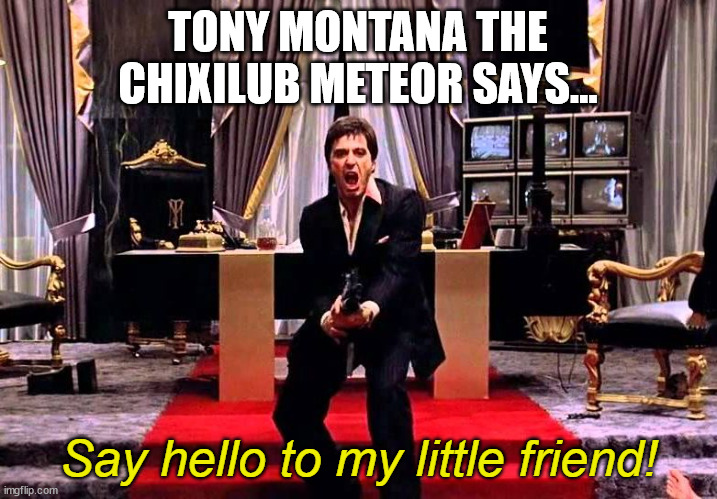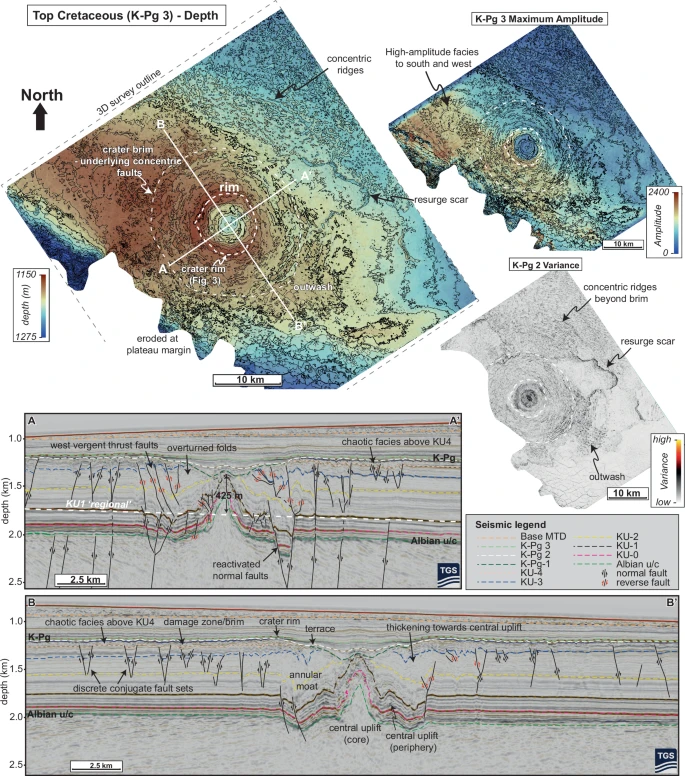
Posted on 10/04/2024 6:33:07 AM PDT by Red Badger
The crater lies deep beneath the Atlantic Ocean and was formed around 66 million years ago – making it a contemporary of Chicxulub.

It is thought that the asteroid hit Earth at around 72,000 kilometers (44,700 miles) per hour.
Image credit: muratart/Shutterstock.com
Some 66 million years ago, a massive asteroid slammed into Earth. The Chicxulub impactor, as it is called, famously wiped out the non-avian dinosaurs and left a huge crater at the edge of the Yucatán peninsula – but it may not have acted alone. New research has revealed that a second, smaller space rock smashed into our planet during the same era, creating a 9.2-kilometer (5.7-mile) crater deep below the Atlantic.
The Nadir Crater was discovered back in 2022, located off the coast of Guinea in West Africa and lying 300 meters (984 feet) under the floor of the Atlantic Ocean. It is believed to have been created at the end of the Cretaceous period, around 66 million years ago, right when Chicxulub hit. However, the exact circumstances of how it came to be have remained uncertain – until now. Thanks to the new study, which has mapped the crater in unparalleled detail, researchers have finally confirmed how it was formed.
Using high-resolution, 3D seismic data, the team was able to determine “beyond reasonable doubt” that the crater was caused by an impact.
“This is the first time that an impact structure has ever been imaged fully with high-resolution seismic data like this and it is a real treasure trove of information to help us to reconstruct how this crater formed and evolved,” study author Dr Uisdean Nicholson wrote in a Springer Nature blog post about the latest research.
“There are around 20 confirmed marine craters worldwide, and none of them has been captured in anything close to this level of detail. It’s exquisite,” Nicholson added in a separate statement.
“One way to understand it is to think about a pregnancy ultrasound. A few generations ago, the ultrasound would show a grainy blob. Now you can see the baby’s features in 3D, in incredible detail – including all the internal organs. We’ve gone from 2D, fuzzy imaging to amazing high-resolution imaging of the Nadir Crater.”
From these exceptional images, a clearer picture of what happened 66 million years ago, when the crater formed, has emerged. For instance, the team now knows that the asteroid itself was larger than previously thought, at around 450-500 meters (1,476-1,640 feet) wide. They also believe it came from around 20-40 degrees to the northeast and hit Earth at an astonishing 72,000 kilometers (44,700 miles) per hour – although this still needs to be verified with a new set of impact models.
In addition, the research has shed some light on the timeline of events following the impact.
“After the impact and the central uplift forming, the soft sediments surrounding the crater flowed inwards towards the evacuated crater floor, creating a visible ‘brim’. The earthquake shaking caused by the impact appears to have liquefied the sediments below the seabed across the entire plateau, causing faults to form below the seabed,” Nicholson explained.
“The impact was also associated with large landslides as the plateau margin collapsed below the ocean. As well as this, we see evidence for a train of tsunami waves going away from, then back towards the crater, with large resurge scars preserving evidence of this catastrophic event.”
The researchers still cannot date the event exactly but are continuing their work on the Nadir Crater to try and pinpoint when in the late Cretaceous it was formed, as well as its potential relationship with Chicxulub.
According to Nicholson, there has never been an impact of this size in human history, and so learning more about it could be illuminating – and not just for learning more about what ended the dinosaurs' reign, but for understanding asteroid impacts in general.
“The closest humans have come to seeing something like this is the 1908 Tunguska event,” said Nicholson. “The new 3D seismic data across the whole Nadir Crater is an unprecedented opportunity to test impact crater hypotheses, develop new models of crater formation in the marine environment and understand the consequences of such an event.”
The study is published in Communications Earth & Environment.
I believe they were all burrow dwellers or burrow nesters. As such they were shielded fro the direct effects of global firestorms ignited by falling red hot secondary debris, and they were also accustomed to CO2 enriched O2 depleted confined spaces.
For them the post-impact above ground atmosphere would be tolerable.

Too late...................😎

Biologists have revised their ideas of what dinosaurs were in recent years, and recent taxonomy reflects that. Chicken-sized dinosaurs didn't go extinct. We have them today. In fact, you can eat some for lunch. They're called "chickens".
Amazing...................
Pangaea broke up at the Jurassic-Triassic boundary (250 mya). This is the end of the Cretaceous (66 mya). Africa and South America had separated, but the Atlantic was narrower than it is today.
good shot then
If they came within even an era of each other, it would more fully explain the extinction event, particularly if Chubby came first. Life is not great at bouncing back from a one-two tap.
As we saw with the Jupiter collision, there may be more craters undiscovered that added to the disaster. ......................
Chickens.
Well, that sure opens the door to a whole new generation of Juraissic Park remakes.
says any well dressed Sicilian.
We will all get firsthand experience with calamitous impacts after NASA finalizes it moronic plan to sample Apophis in a few years...
It’s a guarantee that Apophis’ future paths near or onto Earth will be adversely impacted by these planned experiments...
April 13, 2036. is looking, more and more, like humanity’s end times...
Maybe, if DEI really pays off, NASA will guarantee an impact during its first pass-by on April 13, 2029....
“...famously wiped out the non-avian dinosaurs...”
Thank goodness that the Prehistoric CHICKENS were saved! :)
Disclaimer: Opinions posted on Free Republic are those of the individual posters and do not necessarily represent the opinion of Free Republic or its management. All materials posted herein are protected by copyright law and the exemption for fair use of copyrighted works.